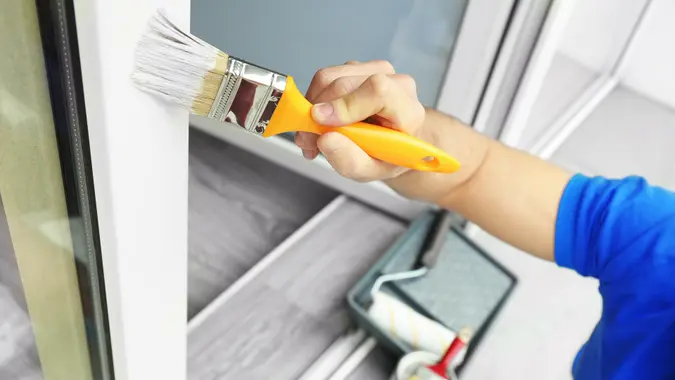Advertiser Disclosure
GOBankingRates works with many financial advertisers to showcase their products and services to our audiences. These brands compensate us to advertise their products in ads across our site. This compensation may impact how and where products appear on this site. We are not a comparison-tool and these offers do not represent all available deposit, investment, loan or credit products.
20 Tips for Negotiating With Car Dealers in 2025
 Written by
Andrew Lisa
Written by
Andrew Lisa
 Edited by
Gary Dudak
Edited by
Gary Dudak

Commitment to Our Readers
GOBankingRates' editorial team is committed to bringing you unbiased reviews and information. We use data-driven methodologies to evaluate financial products and services - our reviews and ratings are not influenced by advertisers. You can read more about our editorial guidelines and our products and services review methodology.

20 YearsHelping You Live Richer

Reviewed by Experts

Trusted by Millions of Readers
Getting a new car is exciting. Buying one, on the other hand, is stressful, time-consuming, overwhelming and riddled with ways to lose money.
When you’re considering getting into a new set of wheels but you’re not sure what to expect or how to handle yourself, consider the following tips before you walk into your first dealership.
Do Your Shopping at Home
Never begin your shopping journey in a dealership showroom. In fact, visiting a dealer is one of the last steps in the process. Always start by narrowing down your choices based on your needs, wants and budget — at home online, not at the dealership. Know the exact make, model and trim package you want.
If you walk into the dealership blind and announce that you’re just “looking around,” you give all the leverage to the salesperson who will then gladly “help” you find the car that’s right for you to buy — but really the one that’s right for them to sell.
Do Your Homework
Before you ever walk into a dealership, make sure you gather as much information as possible about the car you have your eye on. That includes the resale value, average cost of ownership and the commonly paid price.
That’s not the MSRP. Instead, use a tool like the Edmunds True Market Value (TMV) finder, which will tell you what people in your area actually end up paying for the exact car you want.
Get Preapproved
One of the best things you can do to get the best possible deal is to walk into the dealership armed with preapproved financing. When you get preapproved, you’re not at the mercy of the dealership’s financing arm, where they make most of their money. You can always apply for financing to see if they can beat what your lender offered, but if not, you’ll be able to drive away knowing you got the best rate possible.
Consider a Credit Union
Unlike banks and other traditional lenders, credit unions are member-owned nonprofits. Because they don’t answer to quarterly profits-obsessed shareholders, they are often able and willing to give better rates on loans to their members. Sometimes, they’re even able to work with members whose shaky credit might keep them from getting a traditional loan.
Shop Around
Buying a car is exciting, and you might be tempted to jump into the first deal you’re offered if it seems like a steal. It might be, but despite what the dealer says, it will still be there in a few days. Shop around. It’s likely that several dealers in your area are selling the car you want. Visit as many of them as you can — at least three — compare offers and let them know you’re doing it to try to stoke a bidding war for your business.
E-Negotiate
If you are shopping around at multiple dealers, Credit Karma suggests emailing all the dealers you’re considering and trying to negotiate a price online. This is obviously faster and easier than physically visiting multiple dealerships, but the real benefit is that it allows you to conduct a side-by-side comparison of the same vehicle right there at your laptop.
Avoid the Weekends
According to Edmunds, the best time to shop for vehicles is on a weekday early in the week. The worst time is the weekend. Weekends are busier, which means the process takes longer, service isn’t as good, you get less individual attention and, most importantly, prices are higher.
Bring Your Research With You
When you do learn about your car’s actual market value, cost to own, manufacturer rebates, etc., print it all out, put it in a folder and bring it with you to the dealership. First of all, it’s handy to be able to refer to your materials when you’re actually looking at the car — it all tends to blur together when you’re researching so many vehicles. Also, it’s good to be able to refer the dealer to what you’ve learned if there are any discrepancies. Finally, it lets the salesperson know you’ve studied up, you know your stuff and you’re not likely to be oversold.
Bring Someone With You
According to Edmunds, you do yourself a service by not strolling into a dealership alone. It’s not unusual for two salespeople to work with you at the same time, and while they might not intentionally be ganging up on you, it might feel like they are. Even if you’re dealing with a solo sales rep, it’s always good to have a second set of eyes on the car and the paperwork, a second brain crunching the numbers and a second opinion on the entire process.
Don’t Let the Salesperson Take the Wheel
You might encounter a salesperson who starts with an “if you like that, you’ll love this” approach in an attempt to steer you away from the vehicle you’ve chosen. According to Car and Driver, this is rarely because they truly think they’ve found something that’s a better fit for your needs and budget. In most cases, they’re trying to unload a vehicle that they need to get rid of and that they think they can sell that day.
Don’t Be Afraid To Ask for a Salesperson Swap
Buying a car can be a very personal and intimate experience, and if your salesperson makes you uneasy or if you feel like you’re being pressured, it’s OK to ask for a pinch hitter. Edmunds calls it “test driving your salesperson.” Just ask to speak to a sales manager, politely ask for a different representative, and your request will almost certainly be granted with no hard feelings.
Don’t Reveal How You Plan To Pay
A dealer is likely to ask if you plan to finance the vehicle through the dealership. Say you haven’t decided and you’ll discuss financing after you come to an agreement on the price of the car.
If the dealer knows you’ve secured a preapproval, the salesperson might go higher on the price of the car to make up for the fact that the dealer won’t be making money on financing. If they know you plan to finance through them, they might go lower on the vehicle price because they know they can juice the loan rate.
Never Agree To an Early Credit Check
If you plan on financing a car, you’ll eventually have to submit to a credit check. According to Car and Driver, however, some dealers will try to get you to consent to a credit check early in the process, perhaps because they have to “screen” potential buyers. Not only does this not benefit you in any way, but so-called hard pulls can actually damage your credit.
Say No to Fees
Some fees, like those associated with destination charges, tax, title and registration, are mandatory and can’t be swept away. According to Consumer Reports, however, many dealers try to slip extra fees into the final bill — and you should contest every one of them.
Dealer prep, vehicle procurement and vehicle prep fees, for example, should be built into the mandatory destination charge. Also argue advertising fees, loan payment fees, market adjustment fees and documentation fees.
Don’t Negotiate Based on MSRP
Salespeople are trained to negotiate down based on the car’s MSRP, which is what they’d like to get for the vehicle. Instead, negotiate up based on the car’s invoice price, which is what the dealer paid for the car. Generally, 2% above the invoice price is a fair deal for both parties.
Don’t Negotiate Based on Monthly Payments
Another common tactic is for a dealer to ask how much you want to spend per month. Never fall into this trap. Once a dealer knows your budget, they can sell you almost any car they want. By stretching out the loan terms, they can shoehorn a much more expensive car into your monthly budget.
The problem is you get stuck not only with a more expensive car, but you wind up paying far more money in interest payments — if they’re doing the financing, they win twice. According to AutoTrader, $400 a month for 60 months is enough for a $24,000 car. For 72 months, it’s $28,800, and for 84 months you can get a $33,600 car for the same $400 monthly payment. Determine what you can afford based on a 60-month payment plan and make that your budget.
Negotiate the Final Price Only
One good way to avoid fees altogether, according to Credit Karma, is to negotiate only the final price, sometimes called the out-the-door price or drive-away price. Tell the dealer from the beginning that you’re only willing to negotiate the final price, and that all charges and fees must be included.
Ask To See the Loan Offer
If you do decide that dealer financing is right for you, always ask to see the loan agreement. Most dealers work with third-party partner lenders — dozens of them in some cases. Many of those outside banks allow the dealer to tack on a higher financing rate in exchange for getting them a new customer and doing all the work — and they’re under no legal obligation to tell you if you’re actually getting the rate that the lender offered.
Keep Trade-In Negotiations Separate
Just as the financing and purchase negotiations should be kept separate, so, too, should any discussions about trade-in and purchase. If you’re trading in an old car, negotiate the price of that deal first and separately, and get the trade-in value in writing. Here, too, if you allow the dealer to bundle the negotiations, the salesperson can seesaw the discussion — giving what seems to be a great offer on the trade-in only to make up for it by boosting the cost of the car you’re buying.
Avoid Unnecessary Add-Ons
Your dealer will almost always try to upsell you with add-ons and options, some of which might make perfect sense — perhaps you do want to move up to alloy wheels or an upgraded sound system. Don’t, however, buy into extras that you don’t need or could get somewhere cheaper. Say no to things like window tints, fabric and rust protection, VIN etching, upgraded floor mats, wheel locks or door-edge guards.
More From GOBankingRates
Share This Article:




You May Also Like



4 Tech Devices Boomers Should Buy in Retirement -- Even If They Don't Think They Need Them
November 19, 2025
10 min Read


The Average Thanksgiving Now Costs $952 -- Here's How to Cut That Down
November 21, 2025
10 min Read








Best Ways To Save Your Money
Make your money work for you
Get the latest news on investing, money, and more with our free newsletter.
By subscribing, you agree to our Terms of Use and Privacy Policy. Unsubscribe at any time.


Thanks!
You're now subscribed to our newsletter.
Check your inbox for more details.



Sending you timely financial stories that you can bank on.
Sign up for our daily newsletter for the latest financial news and trending topics.
For our full Privacy Policy, click here.
Looks like you're using an adblocker
Please disable your adblocker to enjoy the optimal web experience and access the quality content you appreciate from GOBankingRates.
- AdBlock / uBlock / Brave
- Click the ad blocker extension icon to the right of the address bar
- Disable on this site
- Refresh the page
- Firefox / Edge / DuckDuckGo
- Click on the icon to the left of the address bar
- Disable Tracking Protection
- Refresh the page
- Ghostery
- Click the blue ghost icon to the right of the address bar
- Disable Ad-Blocking, Anti-Tracking, and Never-Consent
- Refresh the page





